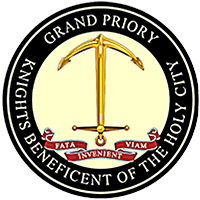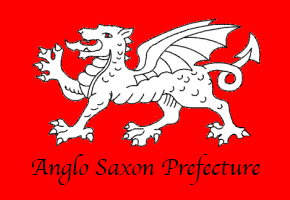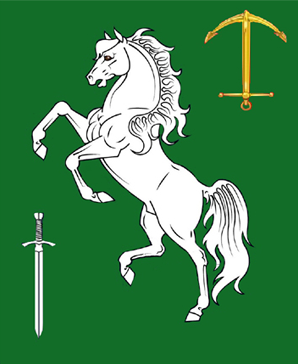 Knights Beneficent of the Holy City
Knights Beneficent of the Holy City
Scottish Masters of St Andrew
Scottish Masters of St Andrew works in the Rectified Scottish Rite, and the Anglo Saxon Prefecture covers several Knight Templar Provinces. Kent has its own Lodge, called Cantwara Invicta Lodge of Scottish Masters of St. Andrew.
The Knights Beneficent of the Holy City (KBHC) is the anglicised name of a very old and very "elite" masonic body known worldwide as "CBCS", short for "Chevaliers Bienfaisant de La Cite Sainte".
There are several "obediences" in this Order, which do not officially recognise each other, but in England particularly, Regular Membership of CBCS was traditionally restricted to literally just a handful of the most senior Knights Templar!
However, many English masons, quite legitimately, took the step of crossing the Channel to Belgium, where membership was more easily obtainable.
Recently, in only 2007, the Grand Priory of Belgium sanctioned England to work the Degrees of the Order, forming part of the Rectified Scottish Rite, more openly, but still in a quite restricted, "Invitation Only" manner.
There follows a few notes on the Order and how it is practised in England, and more particularly in Kent.
The Rectified Scottish Rite Historical Note
It is an acknowledged fact that admission into the Rectified Scottish Rite is a privilege which is only extended to brethren of the Temple who have demonstrated by their general demeanour, and qualities of humility and dignity, that they are worthy of consideration for membership of this elite Christian Order.
The establishment of this select brotherhood evolved after a close examination of the Strict Observance system (founded in 1754) at the Assembly of Lyons held in 1788, under the aegis of the Duke of Brunswick, following which, extensive deliberations resulted in the Order being 'rectified' into its present form at the Assembly of Wilhelmsbad in 1782. This distinguished Order with its centre in Zurich, Switzerland, has continued to the present day, in consequence of which, it can rightfully claim precedence as the most ancient and senior body within the realms of Christian Masonry.
Governance
The Grand Priory of England is governed by the Grand Master, who is supported by a Grand Prior, a Grand Chancery and a retinue of Grand Officers who are his advisers and assist in the administration of Grand Priory, a meeting of which is convened at least once in every year.
The Prefectures of the Order are administered by a Regional Grand Prefect, who in turn is advised and supported by a Chapter of the Prefecture, which must consist of not less than nine Knights. He is responsible for all activity within the jurisdiction over which he presides, and is empowered to appoint a roll of officers to assist him in the government of the Prefecture. Each Prefecture currently exercises authority over its Lodges of Scottish Masters of St. Andrew.
Degrees of the Rite
The first three degrees of the Rite are synonymous with those of the Craft, and are administered by the Grand Lodge of the respective jurisdiction. The remaining three degrees are conferred under the aegis of the National Grand Priory concerned, and comprise:
4. (a) Scottish Master (b) Scottish Master of St. Andrew
which are conferred in a Lodge of St. Andrew by a Worshipful Deputy Master and his team of officers. The degrees collectively embody a revelation that the Temple of the old tradition, also alludes to the treasures revealed through the risen Christ. A regular attendance and a minimum period of at least two years’ service is required before a Brother can be considered for advancement into a Chapter of the Interior Order. The aspirant is here elevated to the rank of:
5. Squire Novice
A degree which can be conferred within a Chapter of Squire Novices by the Grand Master or Regional Grand Prefect and officers of the Prefecture. This and the 6th degree are currently performed at the Anglo Saxon Prefecture. In this degree the aspirant is instructed that it is essential to draw away from the domination of materialism in order to obtain a full and complete understanding of the Supreme Being. A regular attendance as well as a further period of at least two years in that degree must have elapsed before consideration can be given for an Squire Novice to be elevated to the sublime rank of:
6. Knight Beneficent of the Holy City
This supreme grade of the Rite is conferred by the Grand Master or Regional Grand Prefect who is empowered by edict of the Grand Master to bestow the accolade. Therein the postulant is exhorted to render due obedience by a faithful observance of God's Law, and that well-informed tolerance, high morals and regular conduct are all necessary qualities for those who seek reception into Knighthood. It embodies the uplifting Ceremony of Armament, of Dubbing and of Consecration, as derived from the general order of Chivalry.
This supreme degree of the Rite is conferred by the Grand Master or Regional Grand Prefect who is empowered by edict of the Grand Master to bestow the accolade. Therein the postulant is exhorted to render due obedience by a faithful observance of God’s Law, and that well-informed tolerance, high morals and regular conduct are all necessary qualities for those who seek reception into Knighthood. It embodies the uplifting Ceremony of Armament, of Dubbing and of Consecration, as derived from the general order of Chivalry.
The First Grand Master of the Grand Priory of England was the Most Eminent & Reverend Knight Leslie Felgate Dring, GCHC, who was also ME&S Grand Master of Knights Templar of England & Wales etc., until his retirement in early 2011.
The current Grand Master is:
M.Em. & Revd.Kt. Dr Vivian Thomas, JP, G.C.H.C

Anglo Saxon Prefecture regulates the Order in the Templar Provinces of Kent, Surrey, Sussex, London, Middlesex, Hertfordshire, Essex & Oxfordshire, Berkshire & Buckinghamshire.
The Regional Grand Prefect is:
Right Reverend Knight David Jordan, KBHC
The Dragon emblem has been associated with England for over a thousand years. The English Dragon was first referenced by Nennius who talked of a Dragon representing the Saxons in 'Historia Britonum'. Both Henry of Huntingdon and Matthew of Westminster talked of a Golden Dragon being raised at the Battle of Burford in 752AD. The ancient dominant Kingdom of Wessex used a Golden Dragon as its emblem. King Harold II raised the Dragon standard at Hastings in 1066. Geoffrey of Monmouth talked of a White Dragon representing the Saxons in 'Historia Regum Britanniae'. Richard the Lionheart raised the 'terrible standard of the Dragon...' in the crusades of 1191. Henry III issued a mandate 'to cause a Dragon to be made in a fashion of a standard....' in 1216. Edward III raised 'his unconquerable standard of the Dragon Gules' at the battle of Crecy in 1346. Henry V raised the Dragon standard at Agincourt in 1415. The Dragon was with us for hundreds of years and still remains an ancient emblem of England.
Cantwara Invicta Lodge of Scottish Masters of St. AndrewThe current Grand Master is:
M.Em. & Revd.Kt. Dr Vivian Thomas, JP, G.C.H.C

Anglo Saxon Prefecture regulates the Order in the Templar Provinces of Kent, Surrey, Sussex, London, Middlesex, Hertfordshire, Essex & Oxfordshire, Berkshire & Buckinghamshire.
The Regional Grand Prefect is:
Right Reverend Knight David Jordan, KBHC
The Dragon emblem has been associated with England for over a thousand years. The English Dragon was first referenced by Nennius who talked of a Dragon representing the Saxons in 'Historia Britonum'. Both Henry of Huntingdon and Matthew of Westminster talked of a Golden Dragon being raised at the Battle of Burford in 752AD. The ancient dominant Kingdom of Wessex used a Golden Dragon as its emblem. King Harold II raised the Dragon standard at Hastings in 1066. Geoffrey of Monmouth talked of a White Dragon representing the Saxons in 'Historia Regum Britanniae'. Richard the Lionheart raised the 'terrible standard of the Dragon...' in the crusades of 1191. Henry III issued a mandate 'to cause a Dragon to be made in a fashion of a standard....' in 1216. Edward III raised 'his unconquerable standard of the Dragon Gules' at the battle of Crecy in 1346. Henry V raised the Dragon standard at Agincourt in 1415. The Dragon was with us for hundreds of years and still remains an ancient emblem of England.
 This Lodge covers the K.T. Province of Kent and was consecrated on 24th November 2015 at the Wrotham Masonic Hall where it now meets three times a year. Previously Suth Seaxe Lodge covered Kent, Surrey and Sussex and many members of this Lodge became Founders of Cantwara Invicta. Membership is by invitation only but further information can be obtained from the Provincial Vice-Chancellor of K.T.
This Lodge covers the K.T. Province of Kent and was consecrated on 24th November 2015 at the Wrotham Masonic Hall where it now meets three times a year. Previously Suth Seaxe Lodge covered Kent, Surrey and Sussex and many members of this Lodge became Founders of Cantwara Invicta. Membership is by invitation only but further information can be obtained from the Provincial Vice-Chancellor of K.T.